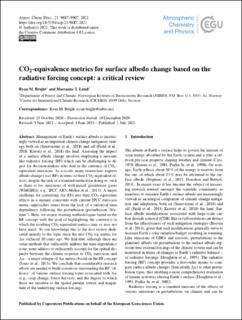| dc.description.abstract | Management of Earth’s surface albedo is increasingly viewed as an important climate change mitigation strategy both on (Seneviratne et al., 2018) and off (Field et al., 2018; Kravitz et al., 2018) the land. Assessing the impact of a surface albedo change involves employing a measure like radiative forcing (RF) which can be challenging to digest for decision-makers who deal in the currency of CO2- equivalent emissions. As a result, many researchers express albedo change (1α) RFs in terms of their CO2-equivalent effects, despite the lack of a standard method for doing so, such as there is for emissions of well-mixed greenhouse gases (WMGHGs; e.g., IPCC AR5, Myhre et al., 2013). A major challenge for converting 1α RFs into their CO2-equivalent effects in a manner consistent with current IPCC emission metric approaches stems from the lack of a universal time dependency following the perturbation (perturbation “lifetime”). Here, we review existing methodologies based on the RF concept with the goal of highlighting the context(s) in which the resulting CO2-equivalent metrics may or may not have merit. To our knowledge this is the first review dedicated entirely to the topic since the first CO2-eq. metric for 1α surfaced 20 years ago. We find that, although there are some methods that sufficiently address the time-dependency issue, none address or sufficiently account for the spatial disparity between the climate response to CO2 emissions and 1α – a major critique of 1α metrics based on the RF concept (Jones et al., 2013). We conclude that considerable research efforts are needed to build consensus surrounding the RF “efficacy” of various surface forcing types associated with 1α (e.g., crop change, forest harvest), and the degree to which these are sensitive to the spatial pattern, extent, and magnitude of the underlying surface forcings. | en_US |

